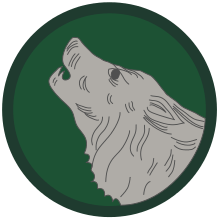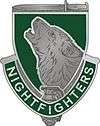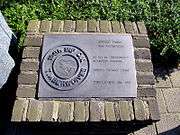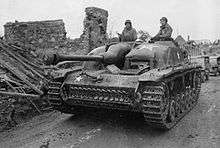104th Infantry Division (United States)
The 104th Infantry Division was an infantry division of the United States Army. Today, it is known as the 104th Training Division (Leader Training) and based at Fort Lewis, Washington, as a training unit of the United States Army Reserve.
| 104th Training Division | |
|---|---|
 104th Division insignia | |
| Active | 24 June 1921 – 20 December 1945 1 December 1946 – present |
| Country | |
| Allegiance | |
| Branch | Army Reserve |
| Type | Training Division |
| Role | Training |
| Size | Division |
| Garrison/HQ | Fort Lewis, Washington |
| Nickname(s) | "Timberwolf Division"[1] "Nightfighters"[2] |
| Motto(s) | "Nothing in Hell can stop the Timberwolves"[1] "We Succeed"[3][4] |
| Engagements | World War II
|
| Commanders | |
| Commanding officer | Brigadier General Rodney J. Fischer |
| Command Sergeant Major | Command Sergeant Major Neil Pierce |
| Notable commanders | Gilbert R. Cook (1942–1943) Terry de la Mesa Allen, Sr. (1944-1945) |
| Insignia | |
| Distinctive Unit Insignia |  |
Activated in 1921 and deployed during World War II, the division saw almost 200 days of fighting in northwestern Europe as it fought through France, Belgium, and western Germany, fighting back several fierce German counterattacks as it advanced through the theater throughout late 1944 and 1945. This was the only combat duty that the 104th Infantry Division has served during its history. At the end of the fighting on 7 May 1945 (V-E Day), this division was in central Germany opposite the troops of its allies from the Soviet Army.
After World War II, this division was reorganized primarily as a training division for Reserve forces. After several decades, the division then expanded its role to conducting entry-level training for soldiers of all branches of the Army in the northwestern United States. Its role and size have expanded over that time due to the consolidation of other training commands, and the division subsequently took charge of a number of brigades specializing in various entry-level training for soldiers of all types.
History
Interwar period
The 104th Infantry Division was first constituted on 24 June 1921 as the 104th Division, before being organized and activated in October of that year in Salt Lake City, Utah.[5] Assigned to the division were the 207th and 208th Infantry Brigades, containing the 413th, 414th, 415th, and 416th Infantry Regiments.[6] As a unit of the Organized Reserves, the division's subordinate units were spread among the states of Idaho, Montana, Utah, and Wyoming.[7] In 1924 it received its shoulder sleeve insignia.[2] The division would not see significant duty until World War II.[8]
World War II
At the outbreak of World War II, the 104th Infantry Division began preparing to participate in the war in Europe. The division was ordered into active military service on 15 September 1942 under the command of Major General Gilbert R. Cook, and was reorganized as the 104th Infantry Division at Camp Adair, Oregon.[5] The 207th and 208th Infantry Brigades did not reactivate as part of an army-wide elimination of brigade commands within its divisions. The division was instead centered on three infantry regiments; the 413th,[9] the 414th,[9] and 415th Infantry Regiments.
Order of battle
- Headquarters, 104th Infantry Division
- 413th Infantry Regiment
- 414th Infantry Regiment
- 415th Infantry Regiment
- Headquarters and Headquarters Battery, 104th Infantry Division Artillery
- 385th Field Artillery Battalion (105 mm)
- 386th Field Artillery Battalion (105 mm)
- 387th Field Artillery Battalion (155 mm)
- 929th Field Artillery Battalion (105 mm)
- 329th Engineer Combat Battalion
- 329th Medical Battalion
- 104th Cavalry Reconnaissance Troop (Mechanized)
- Headquarters, Special Troops, 104th Infantry Division
- Headquarters Company, 104th Infantry Division
- 804th Ordnance Light Maintenance Company
- 104th Quartermaster Company
- 104th Signal Company
- Military Police Platoon
- Band
- 104th Counterintelligence Corps Detachment
From that point, it began training at Camp Hyder, California as a division in preparation for deployment to Europe. The division trained in the northwestern United States during the next two years, earning its name "Timberwolf Division" from its time in the area.[1] The division was the first U.S. Army division to be trained to fight in nighttime conditions.[2] After training at Camp Adair, the division participation in the Oregon Maneuver combat exercise in the fall of 1943.[10][11] On 15 October 1943, Major General Terry de la Mesa Allen, Sr. took command of the division.[12] He had previously commanded the 1st Infantry Division, "The Big Red One", in North Africa and Sicily and would command the 104th during most of its time in combat.[13]
Europe

The 104th Infantry Division sailed for the Western Front on 27 August 1944.[14] It landed in France on 7 September 1944.[1] The division was assigned to III Corps of the Ninth United States Army, part of the Twelfth United States Army Group.[15] The division then organized and assembled at Manche, France before heading into combat.[16]
Joining the Battle of the Scheldt, the division moved into defensive positions in the vicinity of Wuustwezel, Belgium on 23 October 1944. The Timberwolves were then assigned to British Field Marshal Bernard Montgomery's Anglo-Canadian 21st Army Group under the British I Corps, along with the U.S. 7th Armored Division, in order to clear out the Scheldt Estuary and open the port of Antwerp. While the U.S. 7th Armored Division was assigned static duty holding the right flank of the gains made during the failed Market Garden operation, the 104th Infantry Division was to assist the First Canadian Army in the taking of the Scheldt. The Timberwolves travelled across France by train and debarked near the Belgian-Dutch border and waited for word to take part in a new allied offensive, Operation Pheasant, taking the place of the experienced British 49th Infantry Division on the left flank and the Polish 1st Armored Division on the right.
The Americans were given responsibility for taking 22 miles of wet, low country from the Belgian border to the Maas River. The width of their front was approximately 8,000 yards. General Allen planned to employ all three of his regiments at the same time, shoulder to shoulder. The 104th began combat operations on 25 and 26 October and began to attack the Germans, who offered varying levels of resistance. Along the division's front, the Germans were spread thinly and did not have continuous lines of defense. However, they did possess deadly strong points and endeavored to make the Timberwolves' progress as time-consuming and costly as possible, making heavy use of mines, booby traps, and roadblocks. Despite this, the advance was steady, though paid for in the lives of the 104th Division soldiers. Conditions were rainy, chilly, wet, and muddy. Moisture seemed to grip everything and everyone. Sleet beat down on the troops, who went for days soaked to the skin and slimy with mud.[17] On 30 October, after five days of continuous operations the division had pushed about 15 miles to within sight of the Mark River and had liberated Zundert, gained control of the Breda-Roosendaal Road, and overrun the Vaart Canal defenses.[14] Leur and Etten fell as the division advanced to the Mark River, arriving there by 31 October.[14] A coordinated attack over the Mark River at Standdaarbuiten on 2 November established a bridgehead and the rest of the division crossed the river. With the Allies firmly on the north side of the Mark River, German resistance collapsed. For the next two days, the Timberwolves pursued enemy remnants north to the Maas River. Zevenbergen was captured and the Maas River was reached on 5 November.[14] That same day, General Allen received orders from the U.S. First Army, releasing it from British control. While the bulk of the division moved near Aachen, Germany, elements remained to secure Moerdijk until 7 November, when they were relieved.[14] During this time, the division was reassigned to VII Corps of the U.S. 1st Army, also part of the Twelfth Army Group.[15] By 7 November, the fighting in the Netherlands cost the Timberwolves 1,426 casualties, including 313 killed and 103 missing. Montgomery and the Canadian commanders sent their congratulations, and General Allen disseminated copies of their letters to his regiments and wrote a personal letter of thanks to everyone in the division, concluding with his favorite motto, "Nothing in Hell must stop the Timberwolves!" As a result of the actions of the 104th and their Allied counterparts, the Scheldt Estuary was cleared. The Royal Navy took three weeks to sweep the estuary waters clear of mines, and in early December 1944, the port of Antwerp was open to Allied shipping.

While under American command on 16 November 1944, the division went on another offensive in support of Operation Queen, taking Stolberg and pushing on against heavy resistance.[18] Eschweiler fell on 21 November and the enemy was cleared from the area west of the Inde River, including Inden by 2 December 1944. Lucherberg was held against enemy counterattacks on 3 December, and all strongholds west of the Roer River were captured by the 23rd.[18] It took temporary command of the 60th Infantry Regiment of the 9th Infantry Division.[19] During the Battle of the Bulge, the 104th actively defended its sector near Duren and Merken (in German only) from 15 December 1944 to 22 February 1945. During that time, it was reassigned to XIX Corps of the Ninth United States Army.[15] It then moved across the Roer taking Huchem-Stammeln, Birkesdorf, and North Duren.[18] On 5 March, after heavy fighting, it entered Köln. After defending the west bank of the Rhine River, the division crossed the river at Honnef on 22 March 1945, and attacked to the east of the Remagen bridgehead.[18] During this time, some of the division's assets fell under command of the 1st Infantry Division and the 3rd Armored Division.[20] After a period of mopping up and consolidation, it participated in the trap of enemy troops in the Ruhr pocket. The 104th repulsed heavy attacks near Medebach and captured Paderborn on 1 April 1945.[18] After regrouping, it advanced to the east and crossed the Weser River on 8 April, blocking enemy exits from the Harz Mountains. On 11 April 1945 the Division was involved in the liberation of a large German concentration camp at Nordhausen.[21] The division then crossed the Saale River and took Halle in a bitter five-day struggle from 15 to 19 April.[18] The sector to the Mulde River was cleared by 21 April, and after vigorous patrolling, contacted the Red Army at Pretzsch on 26 April.[18] The division took temporary command of assets from the 69th Infantry Division in early May.[19]
Casualties
Demobilization
The division returned to the United States on 3 July 1945. Upon return, it continued the process of demobilization until 20 December of that year, when it was inactivated.[23]
During World War II, soldiers of the division were awarded two Medals of Honor, 14 Distinguished Service Crosses, one Distinguished Service Medal, 642 Silver Star Medals, six Legion of Merit medals, 20 Soldier's Medals, 2,797 Bronze Star Medals, and 40 Air Medals.[14] The division received 9 Distinguished Unit Citations and three campaign streamers during 200 days of combat.[14]
Training Division
The division was reactivated on 1 December 1946 in the organized reserves in Portland, Oregon. It began taking on the responsibility of holding training programs for new soldiers of the US Army Reserve. In July 1948, the division held its first session of summer training. By the end of the training, it had turned out 300 new reservists.[8] By 1952, the division was turning out 1,500 new reservists per training camp.[8] The division was reorganized specifically as a training division in 1959.[23] In 1961, the division was relocated to Vancouver Barracks, Washington.[23]
In 1967, the division was reorganized. As part of an army-wide initiative known as the Reorganization Objective Army Division plan, the division's regiments were disbanded and replaced with larger and more versatile brigades.[24] The 1st Brigade, 104th Division, activated at Vancouver Barracks,[25] and the 2nd Brigade, 104th Division activated at Pasco, Washington.[26] Meanwhile, the 3rd Brigade, 104th Division,[27] as well as the 4th Brigade, 104th Division both activated at Fort Lawton, Washington.[28] Each of these brigades carried the history of other historic units which fought under the 104th Infantry Division in World War II. The 104th Division was then assigned the mission of conducting One Station Unit Training, Basic Combat Training, Advanced Individual Training, and Combat Support training.[8] 1st Brigade took on basic combat training, while 3rd Brigade undertook combat support training, 4th Brigade conducted combat service support training.[24]
In 1996, three more brigades were added to the division's structure. The 5th Brigade, 104th Division was activated at Salt Lake City, Utah.[29] The 6th Brigade, 104th Division was activated at Aurora, Colorado.[30] The 7th Brigade, 104th Division activated at Vancouver, Washington.[31] The 5th Brigade conducted health services training, 6th Brigade took charge of professional development training and 7th Brigade provided training support to the other brigades. These units were redesignated from other training commands and put under the command of the division.[24]
%2C_on_Joint_Base_Lewis-McChord.jpg)
Two additional provisional brigades were created under the 104th Division in 1999; the 8th Brigade, 104th Division was created at Fort Lewis as a unit for training Reserve Officers' Training Corps cadets, and the 4690th US Army Reserve Forces School at Fort Shafter, Hawaii was redesignated as the 4690th Brigade, 104th Division, for service as a multifunctional training unit.[32] In 2005, the Base Realignment and Closure suggestions included the closure of the Vancouver Barracks, and the 104th Division was subsequently relocated to Fort Lewis, Washington.[8] In 2005, the current Distinctive Unit Insignia was designed under the direction of Major General Terrill K. (TK) Moffett. The 104th received its new distinctive unit insignia in 2006.[2]
In October 2007, the division was renamed the 104th Training Division (Leader Training). This change reflected a change in the division's mission, specifically training officer and non-commissioned officer candidates in their assigned fields.[2]
Subordinate units
As of 2017 the following units are subordinated to the 104th Training Division (Leader Training):[33]
- 1st Brigade (Leader Training)
- 2nd Battalion, 319th Regiment (Cadet Summer Training)
- 3rd Battalion, 399th Regiment (Cadet Summer Training)
- 4th Battalion, 413th Regiment (Senior Reserve Officer Training Course)
- 3rd Battalion, 414th Regiment (Cadet Summer Training)
- 4th Battalion, 414th Regiment (Senior Reserve Officer Training Course)
- 2nd Brigade (Leader Training)
- 1st Battalion, 398th Regiment (Drill Sergeants)
- 2nd Battalion, 317th Regiment (Drill Sergeants)
- 2nd Battalion, 297th Regiment (Drill Sergeants)
- 3rd Battalion, 304th Regiment (United States Military Academy)
Honors
Unit decorations
| Ribbon | Award | Year | Subordinate Elements | Embroidered | Notes |
|---|---|---|---|---|---|
| Army Superior Unit Award | 1 Jan 2005 – 31 Dec 2006 | 104th Division (Institutional Training), HQ (to include: Headquarters (less detachment), 1st Brigade, 104th Division, 1st Battalion, 414th Regiment, 2d Battalion, 414th Regiment, 1st Battalion, 415th Regiment, 2d Battalion, 415th Regiment, 3d Battalion, 415th Regiment, 1043d Training Detachment, Headquarters, 3d Brigade, 104th Division, 1st Battalion, 104th Regiment, 2d Battalion, 104th Regiment, 3d Battalion, 104th Regiment, 4th Battalion, 104th Regiment, 5th Battalion, 104th Regiment, 1041st Training Detachment, U.S. Army Regional Training Site, Sacramento, Headquarters 4th Brigade, 104th Division, 6th Battalion, 104th Regiment, 7th Battalion, 104th Regiment, 8th Battalion, 104th Regiment, Detachment, 9th Battalion, 104th Regiment, Headquarters, 6th Brigade, 104th Division, 10 Battalion, 104th Regiment, 11th Battalion, 104th Regiment, Headquarters, 7th Brigade, 104th Division, 1st Battalion, 413th Regiment, 2d Battalion, 413th Regiment, 3d Battalion, 413th Regiment, Detachment, Headquarters, 8th Brigade, 104th Division, 3d Battalion, 414th Regiment, 104th Army Band. | 2005–2006 | Permanent Orders 147-30[34][35] | |
Campaign Streamers
| Conflict | Streamer | Year(s) |
|---|---|---|
| World War II |
Northern France | 1944 |
| Rhineland | 1944–1945 | |
| Central Europe | 1945 | |
| World War II Victory | None |
Legacy
Several people who served with the 104th Infantry Division later went on to achieve notability for various reasons. Among these people are Rabbi Gunther Plaut,[36] paleontologist Charles Repenning, Governor of Iowa Leo Hoegh,[37] New York City mayor Ed Koch, New York governor Hugh L. Carey, and generals John R. Deane, Jr. and Bryant Moore. In addition, actor James G. Snitzer was a member of the 104th and died in combat in 1945.[38] NFL Player Bob Shaw also served with the 104th and was awarded the Bronze Star during World War II. Screenwriter Paddy Chayefsky also served with the 104th during WW2.
In addition, two soldiers from this division were awarded the Medal of Honor for their service in combat. They are Willy F. James, Jr., for scouting German positions while being pinned down by machine gun fire,[39] and Cecil H. Bolton, who led a company of men on the attack despite wounds from a mortar shell.[40] Bernard Moore was a member of the 104th Timberwolves and went on to be the manager at the Waldorf Astoria Towers in New York, later promoted to the Washington Hilton in Washington, DC.[41]
References
- Order of Battle, p. 410.
- "The Institute of Heraldry: 104th Division". The Institute of Heraldry. Archived from the original on 22 June 2008. Retrieved 30 June 2009.
- "Army Mottos". The Institute of Heraldry. Archived from the original on 14 July 2012. Retrieved 5 August 2012.
- Stein, Barry Jason; Capelotti, Peter Joseph (1993). U.S. Army Heraldic Crests: A Complete Illustrated History of Authorized Distinctive Unit Insignia. Univ of South Carolina Press. p. 107. ISBN 978-0-87249-963-8. Retrieved 5 August 2012.
- Wilson, p. 608.
- McGrath, p. 175.
- McGrath, p. 176.
- "GlobalSecurity.org: 104th Division". GlobalSecurity. Retrieved 23 June 2009.
- Almanac, p. 592.
- "Major Dates", 104th Infantry Division National Timberwolf Association, Wichita, Kansas, 9 September 2010.
- Brogan, Phil F., East of the Cascades (Third Edition), Binford & Mort, Portland, Oregon, 1965, pp. 272–275.
- Key Timberwolf Dates, http://www.104infdiv.org/key%20dates.htm
- Order of Battle, p. 411.
- Almanac, p. 570.
- Order of Battle, p. 415.
- Order of Battle, p. 416.
- September Hope: The American Side of a Bridge Too Far by John C. McManus pp. 406–420
- Almanac, p. 571.
- Order of Battle, p. 413.
- Order of Battle, p. 414.
- "Archives West: Robert Rust photograph collection, 1930–1950". archiveswest.orbiscascade.org. Retrieved 15 March 2018.
- Army Battle Casualties and Nonbattle Deaths in World War II, Final Report (Statistical and Accounting Branch Office of the Adjutant General, 1 June 1953)
- Wilson, p. 607.
- McGrath, p. 227.
- Wilson, p. 609.
- Wilson, p. 610.
- Wilson, p. 611.
- Wilson, p. 612.
- Wilson, p. 613.
- Wilson, p. 614.
- Wilson, p. 615.
- McGrath, p. 228.
- "U.S. Army Reserve > Commands > Functional > 108th TNG CMD". www.usar.army.mil. Retrieved 14 April 2018.
- "PERMANENT ORDER 147-30" (PDF). history.army.mil/. US Army Center of Military History. 3 June 2010. Retrieved 3 June 2014.
- https://www.hrc.army.mil/asset/16333 Unit Award Index 1987– Present
- "Gunther Plaut Biography". Temple Beth Israel. Archived from the original on 21 July 2009. Retrieved 30 June 2009.
- "Obituary: Leo Hoegh, 92, Civil Defense Chief for Eisenhower". The New York Times. 24 July 2000. Retrieved 15 June 2008.
- Truitt, Evelyn Mack (1977). Who was Who on Screen. New York: Bowker. pp. 429–430. ISBN 978-0-8352-0914-4.
- "Medal of Honor Recipients – World War II (A–F)". United States Army. Archived from the original on 3 September 2009. Retrieved 24 April 2008.
- "Medal of Honor Recipients – World War II (G–L)". United States Army. Retrieved 24 April 2008.
- "Bernard J. Moore's Obituary". The Washington Post. Retrieved 14 April 2018.
Sources
- McGrath, John J. (2004). The Brigade: A History: Its Organization and Employment in the US Army. Combat Studies Institute Press. ISBN 978-1-4404-4915-4.
- Wilson, John B. (1999). "104th Division (Training)". Armies, Corps, Divisions, and Separate Brigades. United States Army Center of Military History.
- Army Almanac: A Book of Facts Concerning the Army of the United States. United States Government Printing Office. 1959.
- Greenwald, Robert J., ed. (December 1945). "104th Infantry Division". Order of Battle of the United States Army World War II: European Theater of Operations – Divisions. Paris, France: Office of the Theater Historian. pp. 410–417.
External links
- 104th Infantry Division Association
- 104th Infantry Division Command Personnel
- Lineage at the United States Army Center of Military History
- Timberwolves: The Story of the 104th Infantry Division
- Liberation of Achtmaal by the 415th Regiment of the 104th Inf.Div.
- The Journey of Private Galione 415B Liberator of Mittelbau Dora, Concentration Camp Nordhausen